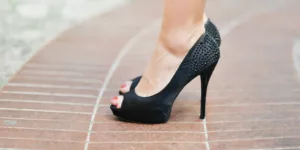Nothing can be more attractive for a woman than a beautiful pair of heels. They look great and make us look even greater, so we definitely love to collect as many heels as possible. But these amazing shoes come with more than a big price tag: they come with lots of pain.
There is a saying that the more beautiful the heels, the more painful they are to wear. Chiropractors know that high heels don’t come only with blisters and feet pain: they can be a lot more dangerous.
Bunions and toe curving
Wearing high heels forces the body to adopt an unnatural position, which might look good, but it is harmful, especially on the long term. In addition to blisters, your feet are forced into an awkward position, with the toes pointed down. The front part of your feet has to support your entire weight, as the center of gravity is changed from the heel to the forefoot. This leads to curving of the toes and bunions. At the same time, your back muscles are contracted, as they try to cope with the change in your walking. This phenomenon is called muscle fatigue by pain management therapists and it leads to back and neck pain.
Tendonitis and sprains
High heels also affect your ankles and the tendons of the foot. The Achilles tendon, which links the heel bone to the calf muscles, is not extended when you wear high heels. When you switch heels with something lower, this tendon is going to stretch, leading to inflammation, pain and tendonitis.
Another side effect of high heels is the risk of ankle sprains, which are usually caused by the fact your contact area with the ground, is smaller and maintaining your balance becomes harder.
The link between high heels and arthritis
Wearing high heels for a long time also forces your knees. The pressure on your knees increases by up to 26%, which leads to pain. On the long term, this increased wear can lead to arthritis.
The effects on your back
Apart from feet and legs, high heels also impact your back and your spine. To maintain your back straight while wearing heels, your spine bends, increasing the curve in your lower back. At the same time, the muscles on your back have to cope with more pressure to keep you straight while walking. Because they are contracted, they become painful and you might even experience soreness in your back. As the spine and the muscles have to cope with added pressure, you can experience pain all the way from your neck to your lower back after wearing heels for a long time.
The most common effects of high heels, like ingrown toenails, corns and aching feet, are reversible. But the conditions described above are not and they are only the peak of the iceberg when it comes to high heels damage. Of course, this doesn’t mean you shouldn’t wear high heels at all, but you should be more mindful when it comes to the height of the heel and for how long you are going to wear them. Seeing a pain management therapist can also help you relieve the pain and some of these side-effects.








